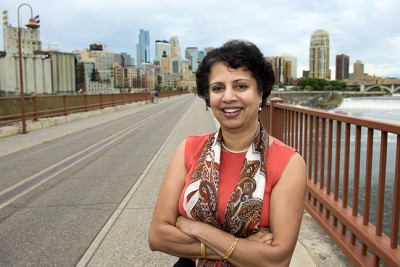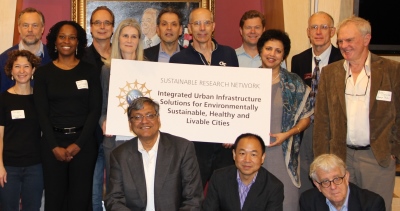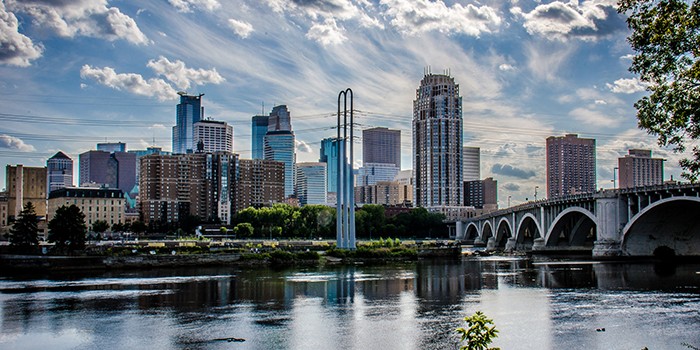Category Archives: Media
News
A better future through “smart cities” research

At the University of Minnesota researchers are teaming up with city planners, nonprofit leaders and industry professionals to form solutions that tackle these emerging challenges and prepare communities for the future.
News
Tech, NSF collaborate to promote sustainability

Professors Armistead Russell and Nisha Botchwey, will lead Georgia Tech’s involvement in the Sustainability Research Network being funded by the National Science Foundation.
News
Reimagining Cities

If ever a project could be held up as a picture-perfect example of the word “interdisciplinary,” this is it.
The U of M’s Anu Ramaswami is directing a vast new network of academics, scientists, industry leaders, and policy partners studying ways to make cities more environmentally sustainable and more tangibly “livable” in ways that advance human health and well-being. Read the full article.
News
News Roundup – Week Two
“Helping Cities Navigate a Climate-Changed Future”
InsideClimate News
August 21, 2015
“Nine universities, backed by NSF grant, research city development in India and USA”
imc, IOT M2M Council
August 18, 2015
News
Helping Cities Navigate a Climate-Changed Future

A Q&A with Anu Ramaswami, an urban sustainability expert at the University of Minnesota, about a new program to make cities sustainable.
Read the full interview on InsideClimate News.
News
IonE Fellow to Lead Global Project on Sustainable Cities

What is a healthy city? How does society weigh the conveniences of transportation, readily available water and electricity, and placement of that new shopping center against the environmental impacts of those assets?
With more than half the world’s population living in cities, building resilient and healthy communities has never been more important. Estimates indicate that by 2050, three billion more people — two-thirds of the world’s population — will inhabit urban areas, increasing pressure on water, energy and land resources.
University of Minnesota researchers — including several Institute on the Environment resident fellows — are part of a global team that has received a $12 million award from the National Science Foundation to bring together a unique network of scientists, industry leaders and policy partners committed to building better cities of the future.
“We have to think in new ways about a city’s physical infrastructure to develop sustainable solutions,” Anu Ramaswami, professor in the Humphrey School of Public Affairs, IonE resident fellow and lead investigator and director for the project, said in a press release. “Understanding that these systems are interconnected serves as a foundation for this work. For example, urban farms wouldn’t work very well without thinking about water, energy and transportation infrastructure, as well as people, markets and policies.”
In this video, Ramaswami and several other members of the project team explain how the project will be implemented.
IonE resident fellows Matteo Convertino, assistant professor in the School of Public Health; Julian Marshall and Paige Novak, professors in the College of Science and Engineering; and Elizabeth Wilson, associate professor in the Humphrey School, are co-investigators on the project.
IonE’s nearly 70 resident fellows — faculty with appointments throughout the University of Minnesota system who come together here to share ideas, inspiration and innovation across disciplinary boundaries — are among the shining stars of IonE’s signature approach to addressing global grand challenges.
This article was originally posted by the Institute on the Environment.
News
CSU Joins Network to Research Sustainable, Livable Cities
Colorado State University researchers will be part of a unique network of scientists, industry leaders and policy partners committed to building better cities of the future.
The consortium, supported by a $12 million Sustainability Research Network award from the National Science Foundation and led by the University of Minnesota, Columbia University and the Georgia Institute of Technology, includes nine universities, major metropolitan areas in the U.S. and India, infrastructure firms and policy groups, all focused on creating cities that are highly functional, promote the health of residents and the environment, and have that intangible “vibe” called livability that makes cities desirable places to live and work.
SRN_livable_cityThe network is the first of its size to focus on ways to reimagine our infrastructure — our energy grids, road networks, green spaces, and food and water systems.
Daniel Zimmerle, senior research associate at Colorado State, will bring his expertise in distributed energy grids to the project. He has been instrumental in the research that has created Fort ZED, the net-zero energy district in Fort Collins and is currently researching micro-grid technology designed to bring energy to rural villages in Rwanda.
“We have to think in new ways about a city’s physical infrastructure to develop sustainable solutions,” said Anu Ramaswami of the Humphrey School of Public Affairs at the University of Minnesota, who is the lead investigator and director for the project. “Understanding that these systems are interconnected serves as a foundation for this work. For example, urban farms wouldn’t work very well without thinking about water, energy, and transportation infrastructure, as well as people, markets and policies.”
Interconnected energy systems
The CSU team will study energy systems interconnected with transportation, water and other systems. The team will utilize data from multiple communities, including Fort Collins, to create simulation models for innovating new methods of optimizing systems.
“Many energy problems have interesting interconnections with social systems or other technical systems. This center will bring together all of the necessary expertise to truly study these interconnections,” said Zimmerle.
Patricia Culligan of Columbia University and Armistead Russell from Georgia Technology are co-directors of the project.
Estimates indicate that by 2050, two-thirds of the world’s population will live in urban areas. Such growth will exert tremendous pressure on water, energy, and land resources, creating traffic congestion, air pollution, and urban inequity that already affects the health of millions of urban residents today. A majority of the infrastructure required to accommodate that future growth has yet to be built, or will need to be rehabilitated from existing systems.
Until now, development trends have resulted in very large infrastructure systems — large power grids, large roadway networks, complex systems that pipe water from distant rivers, and supply food from faraway states and countries. Emerging trends suggest cities may be better off building more local systems — urban farms, local solar generation, bike share systems, and more. This network will try to identify the best mix of local and large to achieve urban sustainability, health and livability goals, by examining infrastructure in diverse cities in the US and India. The team will also explore the public attitudes and policies that can help achieve such urban transitions.
Three themes
The work of the network is organized into three themes.
Theme 1 will develop science-based methods to track the environmental sustainability, health and livability of cities. The various teams will measure the water and energy footprints of cities, the emotional well-being of people in-the-moment as they experience the city, the influence of urban design on air pollution and health, the impact of cities on natural ecosystems, and modeling extreme climate events such as extreme heat and flooding, that impact the livability of cities.
Theme 2 will identify the innovations needed in infrastructure design and in our social institutions to advance environment, health and livability outcomes in cities. In this thematic area, researchers will draw upon new technologies being incubated in university laboratories, as well as infrastructure innovations being piloted in real-world test-beds in our partner cities. Each university in this network is partnering with their local city to explore innovative infrastructure solutions – the network’s test-beds span energy, water, transportation, green infrastructure and food system innovations being piloted in cities in the US and in India.
In Theme 3 the new knowledge created in Themes 1 and 2 will be used to model various policy and technology scenarios in diverse world cities – ranging from small fast-growing cities like Fort Collins to shrinking cities like Detroit, from stable cities with aging infrastructure cities like New York and Minneapolis to young emerging cites in India trying to leap-frog into next generation infrastructure systems.
Working with diverse cities provides rich learning experiences to students, to faculty and to policymakers, as they compare and contrast infrastructure solutions on the ground.
One strength of this network is that each of the nine universities – University of Minnesota, Columbia University, Georgia Tech, Colorado State University, Florida State University, Indian Institute of Technology-Madras, Ohio State University, University of Michigan, and University of Texas-Austin — is working with its local city, as well as with industry partners such as Ecolab, Xcel Energy, and ICF International. In addition, the network’s policy partners such as ICLEI USA, the National League of Cities and the International City Managers Association bring immense capacity to disseminate the findings of the network to more than 29,000 communities in the U.S. and globally.
For more information and a complete list of network partners, visit sustainablehealthycities.org.
– Kate Jeracki
This article was originally posted by Colorado State University.
News
News Roundup – Week One
“U of M Leads Project to Build Sustainable, Livable Cities”
KSTP TV-5, ABC News, Minneapolis/St. Paul
August 12, 2015
“University of Minnesota leads a $12M research network to build healthy, sustainable, and livable cities – Project directed by Professor Anu Ramaswami member of the International Resource Panel”
International Resource Panel, United Nations Environment Programme
August 11, 2015
“FSU earns role in studying how to plan future cities around the globe”
Tallahassee Democrat
August 11, 2015
News
University of Minnesota Leads a $12M Research Network to Build Healthy, Sustainable, and Livable Cities

MINNEAPOLIS/SAINT PAUL — The University of Minnesota has received a $12 million dollar award from the National Science Foundation (NSF) to bring together a unique network of scientists, industry leaders, and policy partners committed to building better cities of the future.
The project is directed by Anu Ramaswami, professor at the Humphrey School of Public Affairs at the University of Minnesota, with co-directors Patricia Culligan at Columbia University and Armistead Russell at Georgia Institute of Technology. The network will connect across nine research universities, major metropolitan cities in the U.S. and India, as well as infrastructure firms, and policy groups. The project includes 25 faculty members across the nine universities, and will involve more than 40 graduate students conducting research in cross-university interdisciplinary teams.
The network is the first of its size to focus on ways to reimagine infrastructure—energy grids, road networks, green spaces, and food and water systems—to create cities that are highly functional, promote the health of residents and the environment, and have that intangible “vibe” called livability, that makes cities desirable places to live and work.
Estimates indicate that by 2050, three billion more people will live in cities, resulting in two-thirds of the world’s population inhabiting urban areas. A majority of the future infrastructure required to accommodate that growth has yet to be built, or will need to be rehabilitated from existing systems. With business-as-usual trajectories, such growth will continue to exert tremendous pressure on water, energy, and land resources, creating traffic congestion, air pollution, and urban inequity that already affects the health of millions of urban residents today.
“We have to think in new ways about a city’s physical infrastructure to develop sustainable solutions,” says Professor Anu Ramaswami, of the Humphrey School of Public Affairs at the University of Minnesota, who is lead investigator and director for the project. “Understanding that these systems are interconnected, serves as a foundation for this work. For example, urban farms wouldn’t work very well without thinking about water, energy, and transportation infrastructure, as well as people, markets, and policies.”
Funded by the NSF’s Sustainability Research Network (SRN) program, the project, titled “Integrated Urban Infrastructure Solutions for Environmentally Sustainable, Healthy, and Livable Cities,” will focus on a new movement gaining momentum in cities around the world toward “distributed,” or more local, infrastructure. Until now, development trends have resulted in very large infrastructure systems—large power grids, large roadway networks, complex systems that pipe water from distant rivers, and supply food from faraway states and countries. Emerging trends suggest cities may be better off building more local systems—urban farms, local solar generation, bike share systems, and more. This network will try to identify the best mix of local and large to achieve urban sustainability, health and livability goals, by examining infrastructure in diverse cities in the U.S. and India. The team will also explore the public attitudes and policies that can help achieve such urban transitions.
“We are a global and urban research university committed to help build better cities,” said University of Minnesota President Eric Kaler, “We’re proud to have our faculty members lead this partnership. Together, scholars, community, industry and policy experts will create a powerful network to identify workable solutions for the challenges facing the world’s cities.”
The work of the network is organized into three themes.
Theme 1 will develop science-based methods to track the environmental sustainability, health and livability of cities. This theme will draw upon UMN researchers from different Colleges and disciplines. For example, at the Humphrey School of Public Affairs, Professor Ramaswami brings expertise in measuring the water and energy footprints of cities, and Associate Professor Yingling Fan is pioneering a new way to measure the emotional well-being of people in-the-moment as they experience the city. Associate Professor Julian Marshall and Assistant Professor Matteo Convertino study the influence of urban design on air pollution and health, bringing perspectives from the College of Science and Engineering, and the School of Public Health, respectively. Minnesota researchers will work with colleagues at the SRN’s partner universities with expertise in complementary areas such as measuring the impact of cities on natural ecosystems, and modeling extreme climate events such as extreme heat and flooding, that impact the livability of cities.
Theme 2 will identify the innovations needed in infrastructure design and in our social institutions to advance environment, health and livability outcomes in cities. In this thematic area, researchers will draw upon new technologies being incubated in university laboratories, as well as infrastructure innovations being piloted in real-world test-beds in our partner cities. For example, in the Minneapolis-Saint Paul (MSP) metropolitan area, Humphrey School Professor Greg Lindsey, and Associate Professors Jason Cao and Jerry Zhao will identify key features that enable our new light-rail, car-share and bike share programs to succeed. College of Science and Engineering Professor Paige Novak will be working with the Met Council to explore the application of new customizable water treatment technologies to treat emerging pollutants, and College of Science and Engineering Assistant Professor Sairaj Dhople and Humphrey School Professor Elizabeth Wilson will evaluate engineering and policy solutions to increase the share of local and renewable energy in our electricity grid. Similar to UMN, each university in this network is partnering with their local city to explore innovative infrastructure solutions – the network’s testbeds span energy, water, transportation, green infrastructure and food system innovations being piloted in cities in the U.S. and in India.
Lastly, Theme 3 will operationalize the new knowledge created in Themes 1 and 2, to model various policy and technology scenarios in diverse world cities – ranging from small fast-growing cities like Fort Collins, Colorado, to shrinking cities like Detroit, Michigan, from stable cities with aging infrastructure cities like NYC and MSP to young cites emerging in India that are trying to leap-frog into next generation infrastructure systems.
Humphrey School Associate Professor Yingling Fan, a co-investigator on the project, notes that “our project presents an exciting new networked model for research and education, where students, faculty, and professional partners from the different universities will take courses together, and, work together to study infrastructure solutions in different cities.”
Each of the nine universities—University of Minnesota, Columbia University, Georgia Tech, Colorado State University, Florida State University, Indian Institute of Technology-Madras, Ohio State University, University of Michigan, and University of Texas-Austin—is working with their local city, as well as with industry partners such as Ecolab, Xcel Energy, and ICF International. In addition, the network’s policy partners such as ICLEI USA, the National League of Cities, and the International City/County Management Association will assist with disseminating research findings to more than 29,000 partners in the U.S. and globally.
“This approach, where university researchers collaborate from the start with cities, policy organizations, and industry partners, will develop solutions that are practical, and can be put into action in cities around the globe,” says Dr. Raj Rajan, RD&E Vice President for Ecolab, and industry lead.
For more information about the project, including the work of individual researchers at partner universities and a complete list of network partners, visit sustainablehealthycities.org.
Anu Ramaswami is the Charles M. Denny Chair Professor of the Science, Technology, and Environmental Policy Program at the Humphrey School, Professor of Bioproducts and Biosystems Engineering in the College of Food, Agricultural, and Natural Sciences, and a resident fellow at the Institute on the Environment.
Leads at the nine universities in this network include:
- University of Minnesota: Anu Ramaswami (Lead PI), Yingling Fan (Co-PI)
- Columbia University: Patricia Culligan (Co-PI), Ben Orlove (Co-PI)
- Georgia Institute of Technology: Armistead Russell (Co-PI), Nisha Botchwey
- Colorado State University: Daniel Zimmerle
- Florida State University: Richard Feiock
- Indian Institute of Technology-Madras: Jessica Seddon
- Ohio State University: Bhavik Bakshi
- University of Michigan: Joshua Newell
- University of Texas-Austin: Kara Kockelman
Co-Principal Investigator
Georgia Institute of Technology
ted.russell@ce.gatech.edu
News
U-M Part of New Network to Build Sustainable, Livable Cities
The University of Michigan is one of nine research universities in a new international effort, funded by a $12 million award from the National Science Foundation, to build better cities of the future.
The University of Minnesota-led project brings together scientists, industry leaders and policy partners committed to creating cities that are highly functional, that promote the health of residents and the environment, and that have that intangible vibe, called livability, that makes cities desirable places to live and work.
The new project, funded by NSF’s Sustainability Research Network, will focus on ways to reimagine the energy grids, road networks, green spaces, and food and water systems that form the urban infrastructure. Emerging trends suggest that cities may be better off building more local systems; this movement toward “distributed” infrastructure is gaining momentum globally.
“We have to think in new ways about a city’s physical infrastructure to develop sustainable solutions,” said Anu Ramaswami of the University of Minnesota, the project’s lead investigator and director. “Understanding that these systems are interconnected serves as a foundation for this work.”
The U-M portion is roughly $750,000 over four years and involves green infrastructure, urban farming — including a Detroit aquaculture project to raise freshwater shrimp — and the investigation of innovative techniques to recover energy and water from wastes.
The principal investigator of the Michigan portion is geographer Joshua Newell, assistant professor of natural resources and environment. The co-principal investigator is Lutgarde Raskin, Altarum/ERIM Russell D. O’Neal Professor of Engineering and professor of civil and environmental engineering.
Green infrastructure includes stormwater management projects such as green roofs, rain gardens, bioswales and tree-lined streets, as well as the greenways, parks, urban farms and protected river basins that weave through a city’s environs. Urban green infrastructure projects benefit natural ecosystems, increase local property values and have other social, economic, health and psychological benefits.
But such projects tend to be driven by stormwater management goals, with few studies examining tradeoffs and potential synergies between a suite of benefits, said Newell.
“We need to consider how these green-infrastructure interventions affect a city’s environmental and social-justice fabric. Are they being placed in communities and neighborhoods that may be especially vulnerable to climate change or that suffer from park poverty?” Newell said. “We need to do a much better job at identifying hotspots in the urban landscape that offer the potential to maximize benefits for the many, rather than the few.”
Michigan researchers and their partners will identify optimal sites — called hotspots — for future green infrastructure and urban agriculture development. To find the hotspots, they will create a “spatial planning model” that integrates key ecological and socioeconomic indicators, including flooding, social vulnerability, park access, air pollution, urban heat islands and green-space connectivity.
The model will be refined using data collected during case studies in Detroit, New York City and Minneapolis-St. Paul.
Raskin’s team will use the hotspots identified by Newell to select locations suitable for the development of community-scale waste treatment systems that recover water and energy from a variety of sources.
A technology called an anaerobic membrane bioreactor will recover energy in the form of methane gas from household wastewater, food waste, garden waste and urban food-production waste. Effluent produced by the bioreactor can be used directly as irrigation water or treated further to produce drinking water.
“The feasibility of using an anaerobic membrane bioreactor in conjunction with urban food production in Detroit will be examined,” Raskin said. “This urban test bed will include a recirculating shrimp aquaculture system focused on the distributed production of freshwater shrimp.”
Partners in the U-M portion of the project include Detroit Future City, the Southeast Council of Michigan Governments, Columbia University’s Earth Institute, the University of Minnesota, and the Metropolitan Council of the Minneapolis-St. Paul metro area.
Michigan faculty collaborators include Steven Skerlos, Arthur F. Thurnau Professor, and professor of mechanical engineering, and environmental engineering, and Jim Diana, professor of natural resources and director of the Michigan Sea Grant. Several U-M graduate students and postdoctoral researchers also will be involved.
The $12 million, NSF-funded Sustainability Research Network project is titled “SRN: Integrated Urban Infrastructure Solutions for Environmentally Sustainable, Healthy, and Livable Cities.” The network will connect research universities, major metropolitan cities in the U.S. and India, infrastructure firms and policy groups.
In addition to Michigan, Minnesota and Columbia, the university partners are Georgia Tech, Colorado State, Florida State, Indian Institute of Technology-Madras, Ohio State and Texas.
The project includes 25 faculty members from the nine universities and will involve more than 40 graduate students conducting research in cross-university interdisciplinary teams.
By 2050, it is estimated that 3 billion additional people will inhabit cities worldwide, meaning that two-thirds of the world’s population will live in urban areas. Most of the infrastructure needed to accommodate that growth has yet to be built or will need to be rehabilitated from existing systems.
The NSF-funded researchers will try to identify the optimal infrastructure mix by examining local and large projects in diverse cities in the U.S. and India. In addition, they will explore the public attitudes and policies that can help achieve the desired urban transitions.
The work is organized into three themes. Theme 1 will develop science-based methods to track the environmental sustainability, health and livability of cities. Theme 2 will identify the innovations needed in infrastructure design and social institutions to advance environment, health and livability outcomes in cities.
In Theme 3, researchers will use knowledge gained in Themes 1 and 2 to model various policy and technology scenarios in diverse world cities. They will examine small, fast-growing cities like Fort Collins, Colo.; shrinking cities like Detroit; stable cities with aging infrastructure like New York City and Minneapolis-St. Paul; and emerging Indian cities that hope to leapfrog into next-generation infrastructure systems.
– Kent Love-Ramirez, University of Minnesota
– Jim Erickson, University of Michigan News Service
This article was originally posted by the University of Michigan.




